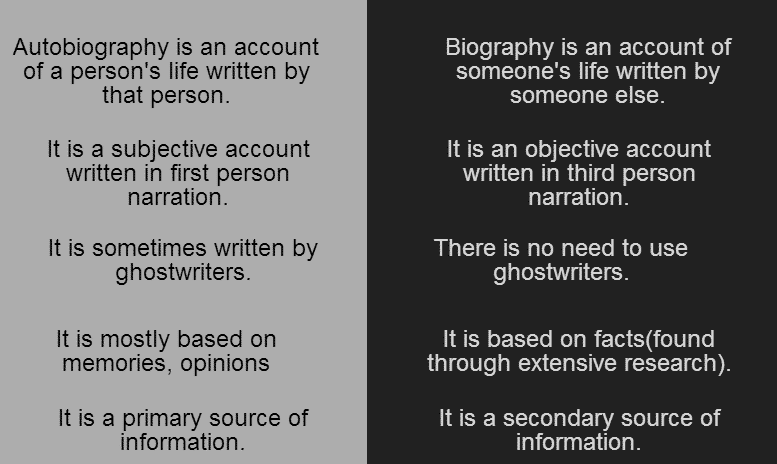Biographies and autobiographies fall under the class of non-fiction writing. And while writing non-fiction can be daunting and research-intensive, it is equally rewarding.
You get the opportunity to narrate a true, fact-based story while making the reading experience enjoyable. Achieving this balance marks the pinnacle of success in your writing career. As such, it is a skill that every writer must aspire to achieve if they want the secret of how to write a good book.
So if you are beginning your journey with a biography or an autobiography, we have the perfect guide to help you. Read on to know everything about the two forms of writing and how it contributes to the style that you must adopt.
Contents
Difference Between a Biography and an Autobiography
Before delving into the writing process, let’s first examine how biographies and autobiographies differ from each other. Here are a few pointers highlighting the main differences:
Basic Definition
A biography is a story of an individual’s life (typically a historical or a public figure) written by another person.
An autobiography is a person’s life story written by themselves. In some instances, the subject may tie up with a writer and co-author the book.
Research Methodology
Typically, the author carries out in-depth research into the subject’s life before they start penning down a biography.
Since autobiographies are about oneself, one does not necessarily need to study the subject.
Subject Consent
Biographies generally require consent from the subject, but it is not mandatory, and as such, you may skip it in some cases.
Autobiographies do not involve any need for consent as the writer is writing about their own life.
Subjectivity/Objectivity
Biographies are based on facts related to the life and journey of the subject and are typically highly objective.
The writing in autobiographies can be relatively subjective since it would also involve thoughts and emotions in addition to the factual events that took place in the subject’s life.
Voice and Narrative
A biography is usually written in the third person, while autobiographies are generally written in the first person.
Objective
The primary purpose of any biography is to inform and educate the reader.
The main objective of autobiographies is to share life lessons and wisdom while also entertaining the reader and explaining the thought and intent behind the subject’s actions and decisions.
Writing Approaches for Biographies and Autobiographies
Now that you know the differences between a biography and an autobiography, it is time to review how one should approach writing the two:
Writing a Biography
Since a biography is a narration of someone else’s life, the author will have to write a novel in the third-person format. Additionally, it adopts a more objective style of writing with a more formal tone.
Biographies generally have a broad scope and cover a vast timeline spanning from their birth to death or current status. Hence, it must involve intricate details about the subject’s life, such as their family background, education, work history, controversies, relationships, death, etc.
Thus, if you wish to solidify your claim as a serious biographer, you would have to study their life collect all the facts, and present them artistically. Eventually, all the research that you put into understanding your subject will form the cornerstone of your prized creation.
Your main goal should be to present an all-around, multi-faceted character sketch of the subject and mark their experiences.
That being said, the practice where authors take the creative freedom to interpret and analyze different aspects of their subject’s life and add a twist to it is not unheard of.
You are free to make such tweaks as long as this interpretation adds value to the book, be it in the form of unraveling their mistakes, connecting factual details, attributing meaning to their actions, highlighting their accomplishments, or even solving mysteries.
You may organize the book in chronological order or divide it into topics or theme-based chapters, such as their achievements, etc.
Some of the best-selling and widely popular biographies include:
- A Beautiful Mind by Sylvia Nasar
- Alan Turing: The Enigma by Andrew Hodges
- Churchill: A Life by Martin Gilbert
- The Immortal Life of Henrietta Lacks by Rebecca Skloot
- Radioactive: Marie & Pierre Curie: A Tale of Love and Fallout by Lauren Redniss
- Steve Jobs by Walter Isaacson
Writing an Autobiography
An autobiography is the retelling of an author’s life from their point of view. Since you are the protagonist in this story, you will have to adopt a first-person narrative. Since autobiographies are based on facts, autobiographers may collaborate with other writers to gain a factual perspective.
While autobiographies are non-fiction, they have the potential for creative narration as you can weave in some storytelling elements, such as highlighting a central conflict, introducing a cast of interesting characters, and so on.
Like biographies, autobiographies detail the writer’s entire life, right from when they are born (and sometimes could even include some family history for context) to the present. Over this period, you will extract all the notable events, reactions, decisions, movements, and all other happenings that take place over time.
Autobiographies may not stray far from facts, but they do include an element of personalization, which allows the writer to connect with the readers. To achieve this effect, the writer may include personal details that develop their story and engage the readers.
With regards to the flow, autobiographies may follow a chronological order, hop between timelines, or make use of flashbacks. It may also leverage unique writing styles, such as the letter or diary formats.
You can draw inspiration from some famous autobiographies, which are as follows:
- The Diary of a Young Girl by Anne Frank
- The Story of My Life by Helen Keller
- Dreams From My Father by Barack Obama
- I Know Why the Caged Bird Sings by Maya Angelou
- Wings of Fire by Arun Tiwari and Dr. A. P. J. Abdul Kalam
- Open by Andre Agassi
- The Autobiography of Mark Twain
Conclusion
You would have to mold your writing style depending on the nature of the book. With the pointers shared above, you can be in a better position to decide all the changes that you will have to incorporate to write a successful autobiography or biography.
With this, we wish you the best on your writing journey!


